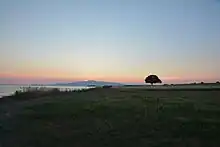 | |
 Shown within Turkey | |
| Location | Yeni Şakran, Izmir Province, Turkey |
|---|---|
| Region | Aeolis |
| Coordinates | 38°52′28″N 27°4′9″E / 38.87444°N 27.06917°E |
| Type | Settlement |
Gryneium or Gryneum or Gryneion (Ancient Greek: Γρύνειον), also Grynium or Grynion (Γρύνιον), Grynia or Gryneia (Γρύνεια) and Grynoi (Γρῦνοι),[1] was a city of ancient Aeolis. It was located 40 stadia from Myrina and 70 from Elaea. In early times it was independent, one of the 12 important cities of Aeolis, but afterwards became subject to Myrina. It contained a sanctuary of Apollo with an ancient oracle and a splendid temple of white marble.[2][3][4][5][6] Because of the city Apollo derived the surname of Gryneus.[7] Pausanias wrote that at Gryneium, where there was an amazing grove of Apollo, with cultivated trees, and all those which, although they bear no fruit, are pleasing to smell or look upon.[8]
Xenophon mentions Gryneium as belonging to Gongylus of Eretria;[9] and it is possible that the castrum Grunium in Phrygia, from which Alcibiades derived an income of 50 talents was the town of Grynium.[10] It was a member of the Delian League.[11]
In 334 BC, Parmenion, who was one of the commanders of Alexander the Great, came to the region before Alexander's invasion took the town by assault, burned it, and sold its inhabitants as slaves, to prevent the resistance of the people around.[12]
Its ruins are near Aliağa in İzmir province of Turkey in western Anatolia. It is on the Aegean coast and very close to the modern town of Yeni Şakran.
The first excavations were made by the French in 1883 and lasted several days. With a few pieces of vase, bronze objects were found. The next excavation was carried out by the Bergama Museum in 1959. During the expansion of Izmir-Çanakkale highway, a beautiful mosaic and necropolis area was found with sarcophagi. Today there has been no construction in the local area and the ruins can easily be seen from a great distance.
References
- ↑ Stephanus of Byzantium, Ethnica, G213.1
- ↑ Herodotus. Histories. Vol. 1.149.
- ↑ Strabo. Geographica. Vol. xiii. p. 622. Page numbers refer to those of Isaac Casaubon's edition.
- ↑ Virgil, Ecl. 6.72, Aen. 4.345; Pliny. Naturalis Historia. Vol. 5.32, 32.21.
- ↑ Stephanus of Byzantium. Ethnica. Vol. s.v. Γρύνοι.
- ↑ Pausanias (1918). "21.9". Description of Greece. Vol. 1. Translated by W. H. S. Jones; H. A. Ormerod. Cambridge, Massachusetts; London: Harvard University Press; William Heinemann – via Perseus Digital Library.
- ↑ Harry Thurston Peck, Harpers Dictionary of Classical Antiquities (1898), Grynēum
- ↑ Pausanias, Description of Greece, 1.21.7
- ↑ Xenophon. Hellenica. Vol. 3.1.6.
- ↑ Nep. Alcib. 9.
- ↑ Athenian Tribute Lists
- ↑ Diodorus Siculus. Bibliotheca historica (Historical Library). Vol. 17.7.
![]() This article incorporates text from a publication now in the public domain: Smith, William, ed. (1854–1857). "Grynium". Dictionary of Greek and Roman Geography. London: John Murray.
This article incorporates text from a publication now in the public domain: Smith, William, ed. (1854–1857). "Grynium". Dictionary of Greek and Roman Geography. London: John Murray.